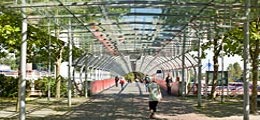The transition toward a more sustainable future, marked by the reduction of carbon and sulfur emissions and the reuse of organic waste, has driven the development of processes based on renewable biomass to produce fuels, chemicals, energy, and materials [1]. This approach reduces dependence on fossil resources and promotes a bio-based economy with the potential to create jobs, foster technological innovation, and open new business opportunities. However, to make these processes viable at an industrial scale, a deeper understanding of the underlying biological mechanisms is essential, particularly regarding the dynamics of microbial communities and the metabolic pathways responsible for generating value-added bioproducts [2]. Brazil, as one of the world’s leading producers of sugarcane, generates millions of tons of agro-industrial residues annually, such as vinasse, bagasse, and straw, whose sustainable management presents both a challenge and a strategic opportunity [3]. In this context, biorefineries have emerged as a promising alternative for the efficient conversion of these residues into renewable energy, such as biogas (methane and hydrogen) and bioactive compounds, including volatile organic acids (VOA), biopolymers (PHA, PHB), and exopolysaccharides. This project, supported by the Alexander von Humboldt Foundation and CAPES, aims to investigate the microbial diversity and metabolic pathways involved in the fermentation of sugarcane residues, with the goal of optimizing bioenergy and bioproduct generation in biorefinery systems. Three distinct Brazilian initiatives focused on sugarcane residue valorization will have their microbial communities characterized through metagenomic and bioinformatic approaches. The study will not only identify genes associated with the production of VOA, biogas, and biopolymers, but also map genes related to microbial resistance to common inhibitors in fermentative processes. The research is being conducted through a collaboration between the Environmental Sanitation Laboratory of the Federal University of Pernambuco (LSA-UFPE) and the Center for Biotechnology at Bielefeld University (CeBiTec), using samples collected from bench-scale anaerobic reactors located in Pernambuco, in northeastern Brazil, one of the country’s main sugarcane-producing regions. The expected outcomes include significant contributions to the improvement of biorefinery processes, the identification of key metabolic routes and potential microbial inhibitions, and the promotion of the sustainable production of bioenergy and high value bioproducts.
- Cherubini, F. (2010). The biorefinery concept: Using biomass instead of oil for producing energy and chemicals. Energy Conversion and Management, 51(7), 1412-1421.
- Kamm, B., & Kamm, M. (2004). Principles of biorefineries. Applied Microbiology and Biotechnology, 64(2), 137–145.
- Vanwonterghem, I. et al. (2014). Deterministic processes guide long-term synchronised population dynamics in replicate anaerobic digesters. The ISME Journal, 8, 2015–2028.
- Soccol, C. R. et al. (2017). Brazilian biofuels and renewable energy: History, present and future. Biofuel Research Journal, 14, 744–753.



